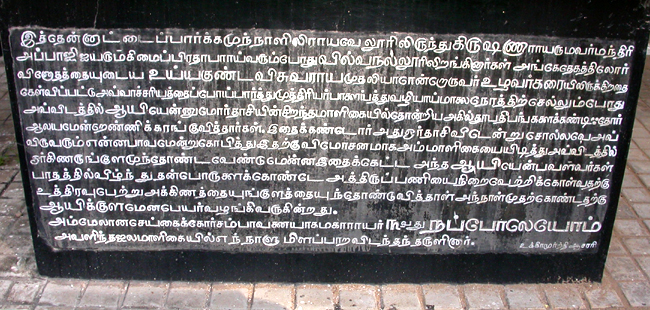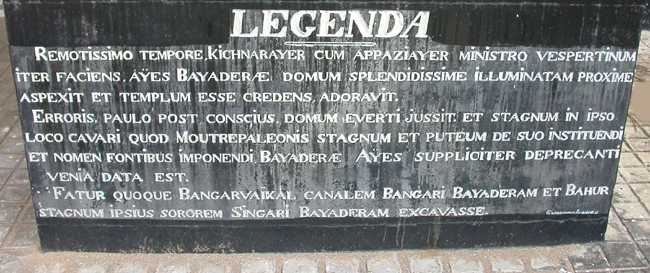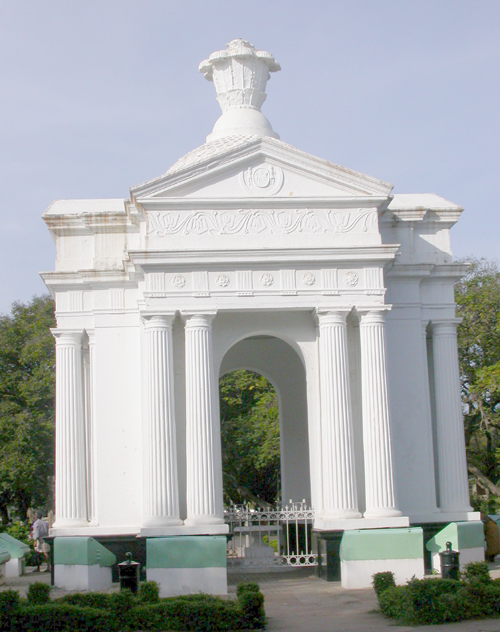|
"To us
all towns are one, all men our kin. |
| Home | Whats New | Trans State Nation | One World | Unfolding Consciousness | Comments | Search |
|
"To us
all towns are one, all men our kin. |
| Home | Whats New | Trans State Nation | One World | Unfolding Consciousness | Comments | Search |
|
Selected Writings - N.Nandhivarman |
|
Pondicherry Stone Inscriptions 27 November 2007 Monuments, Inscriptions and copper plates speak. They reveal the past. Epigraphists unearth history hidden in these. There are around 535 stone inscriptions discovered in and around Pondicherry and these include Sanskrit (4), Kannada (2), Latin (1), French (2), Armenian (1). Most of the inscriptions are in Tamil. Late Pulavar Kuppusamy and Villianur Venkatesan have compiledof these epigraphs. Professor Vijayavenugopal Senior Research Fellow of the Epigraphy Section of Ecole Francaise D' Extreme-Orient of Pondicherry has translated these insciptions and a new book is on the anvil. For more than 1000 years of our history can be traced in these stone inscriptions. The rule of Rastrakooda king Kannaradevan comes to light through 16 inscriptions. Similarly sixteen Chozha Emperors have ruled Pondicherry region, which is recorded in 220 inscriptions. Eight Pandyan kings (18), two later Pallavas (13), thirteen Vijayanagara Kings (27) and three under Sambuvaraiyer (3) are the break up of the total of 535 stone inscriptions found in and around Pondicherry. Almost all major villages of Pondicherry and Karaikal regions have these inscriptions namely Thirubuvanai (188), Madagadipattu (83), Thirunallaru (51), Villianur (50), Thiruvandarkoil (42), Bahour (45), Pondicherry (30). In Karaikal region at Karaikal (10), Thirumalairayanpattinam (6), Nallambal (7), Mathur (1), Nedungadu (1), Sethur (3), Sorakudi (1), Melponsethi (1) Pandasozhanur (7), Thirukanji (3), Kariamaniccam (2), Keezhkasakudi (2), Melkasakudi (1) and Dharmapuram (1). Coming to the recent past a monument of a brave soldier reminds us about the year 1778 when Pondicherry was under siege by the British. The brave sons of Pondicherry with only 1000 soldiers defended their soil fiercely against the 24,000 attackers. An isolated commemorative stele of a brave Englishman Captain Aug de Morgan killed by the French artillery on 11 th October 1778 stands on a barren terrain near Jipmer Hospital. This monument reminds us of not only the bravery of Pondicherrians but also their nobility to pay due respect even to the enemy warrior.
Another Tomb of Pauline de Kerjean nephew of Dupliex, a little girl who served in the Deccan wars epitomizes brave French womanhood." The skulls, bats and tibia are symbols more sinister than comforting flames that represent the eternal soul," writes M.Bourdat, Professor of Literature in Lycee Francaise.
The Annual Reports of Indian Epigraphy 1887-1905 is the first of its kind in Indian subcontinent on listing out the various stone inscriptions. J.Burges, the Director General of Archaeological Survey of India and E.Holtzsch, the Epigraphist of the Archaeological Survey of South India are the pioneers who laid down the foundation for epigraphic studies. In French India at the same time French scholars have unearthed many stone inscriptions. Jouveau Dubaille found a stone monument in the garden in front of present day Raj Niwas which speaks about the fortifications on the shore together with" Port Marine" built by Joseph Françoise Dupliex, the Governor of Pondicherry. While these speak about recent history stone inscriptions are useful to know how this area was ruled. Though 535 epigraphs speak about various rulers for most of the period Pondicherry was part and parcel of Nadu Nadu, which means middle country. There are historical reasons for this region to be called as Nadu Nadu. The Pallava rule did not extend up to Pennaiyaaru and Chozha rule was up to Vellaru. In between these around 10 small states were there such as Vanagoppadi, Singapuranaadu, Oymanaadu, Vesalipadi nadu etc. These areas ruled by small states were called Nadunadu. The Saivite book of hymns Thevaram calls the pilgrimage centers in this region as Nadu Naattu thirupathigal. From these inscriptions we understand how the territory was divided into Mandalam, Kottam, Kootram similar to District, Taluk and Panchayat. The subdivisions for purpose of revenue have been divided into 28 valanaadugal. Athiraja valanaadu was named after Rajathirajan I. This comes to public notice while epigraphists found this inscription at Tirunallar which belonged to the regime of Rajendra II. The newly awaited book by the Ecole Francaise D'Extreme Orient has generated lot of interest among the public, as they are hoping that this book will throw more light on how this region was ruled and what were the social customs prevailing during that period etc. For instance in one inscription dating back to 1000 years in Bahur the word untouchable (Theendathagar) is used, wherein the tank desalting work was forbidden to untouchables since that water reaches the deity. That may be the first instance of that word being used, scholars opine. Stones reflect the societal practices of those days be it good
or bad. A true historical perspective emerges, and Pondicherrians come to
understand their region more with scholars throwing more light. |
 |
 |
 |